IO
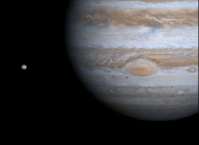 Jupiter
is the largest planet in the solar system. It is so big
that 1300 Earth-size planets would easily fit inside of it.
Scientists have discovered seventeen moons in orbit around
Jupiter, and while each one is unique, none is more
fascinating than one of its innermost moons, Io. Io is one
of four large moons discovered by Galileo in 1610 using one
of the first telescopes ever built.
Jupiter
is the largest planet in the solar system. It is so big
that 1300 Earth-size planets would easily fit inside of it.
Scientists have discovered seventeen moons in orbit around
Jupiter, and while each one is unique, none is more
fascinating than one of its innermost moons, Io. Io is one
of four large moons discovered by Galileo in 1610 using one
of the first telescopes ever built.
For centuries, very little was known about Jupiter and its moons. Because they are so far away, they are very hard to study from Earth. In recent years, however, spacecraft equipped with special instruments have been sent to study Jupiter and its moons in detail, and these have provided us with a great deal of new information.
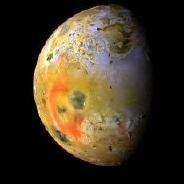 The
first spacecraft to fly past Io was Voyager in 1979,
and scientists were amazed at the first pictures that
were sent back to Earth. Io's surface was discovered to
be a patchwork of red, yellow, orange, and blackish brown
colors which make the moon look somewhat like a gigantic
pizza. Scientists soon discovered that the surface of Io is
almost completely covered with sulfur.
The
first spacecraft to fly past Io was Voyager in 1979,
and scientists were amazed at the first pictures that
were sent back to Earth. Io's surface was discovered to
be a patchwork of red, yellow, orange, and blackish brown
colors which make the moon look somewhat like a gigantic
pizza. Scientists soon discovered that the surface of Io is
almost completely covered with sulfur.
So why is Io's surface so colorful? The reason is that sulfur changes color depending on its temperature. At very high temperatures, sulfur is black. As it gets cooler, the color changes to brown, and then to bright orange as it cools even more. At even lower temperature sulfur is yellow, and when it gets very cold it turns white. Look at this picture of Io and you can easily locate the hottest and coldest areas. Sulfur is commonly found on Earth near areas of volcanic activity, and the source of the sulfur on Io was also found to be from volcanoes. You can always tell when there is sulfur around. It has the nasty smell of rotten eggs. Although scientists thought there would be volcanic activity on Io, they were surprised to see how widespread it was.
Io is similar in size to our own moon but that is the only way that they are similar. Pictures of our moon show no sign of recent volcanic activity. In fact, there has been no volcanic activity on our moon for several billion years. Io not only has active volcanoes, it is the most volcanically active of all the moons and planets in the solar system.
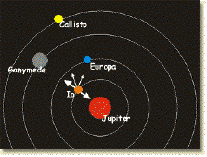 Why does Io have active volcanoes while our moon does not?
Jupiter is a giant planet and because it is so big it places
a huge gravitational pull on its closest moon, Io, far
greater than Earth's pull on our moon. Also, beyond Io there
are three other moons in close orbit around Jupiter--Europa,
Ganymede, and Callisto. Although these moons are small, they
too exert some gravitational pull on Io. Io is caught in the
middle of this tug-of-war. Jupiter pulls Io toward itself,
while the outer moons pull it in the opposite direction.
Because of this Io is squeezed and stretched. This causes
its interior to heat up to very high temperatures.
Eventually cracks form on Io's surface and molten (melted
rock) material from below erupts onto the surface.
Why does Io have active volcanoes while our moon does not?
Jupiter is a giant planet and because it is so big it places
a huge gravitational pull on its closest moon, Io, far
greater than Earth's pull on our moon. Also, beyond Io there
are three other moons in close orbit around Jupiter--Europa,
Ganymede, and Callisto. Although these moons are small, they
too exert some gravitational pull on Io. Io is caught in the
middle of this tug-of-war. Jupiter pulls Io toward itself,
while the outer moons pull it in the opposite direction.
Because of this Io is squeezed and stretched. This causes
its interior to heat up to very high temperatures.
Eventually cracks form on Io's surface and molten (melted
rock) material from below erupts onto the surface.
 Some
of the first images from Io showed material being thrown
upward from the surface into space. At first scientists
thought these might be similar to explosive volcanic
eruptions on Earth such as the eruption of Mt. St. Helens.
After further study, however, they decided that the
eruptions are more closely related to geysers on Earth.
Geysers are found in volcanically active regions on Earth
such as in Iceland, New Zealand, and Yellowstone National
Park in Wyoming. Geysers occur when water located in open
spaces beneath the Earth's surface comes into contact with
hot rocks. As the water heats up, pressure builds up within
the confined space. Eventually the water expands and is
forced upward through cracks in the overlying rock This
results in an eruption of steam and water from the crack.
Some
of the first images from Io showed material being thrown
upward from the surface into space. At first scientists
thought these might be similar to explosive volcanic
eruptions on Earth such as the eruption of Mt. St. Helens.
After further study, however, they decided that the
eruptions are more closely related to geysers on Earth.
Geysers are found in volcanically active regions on Earth
such as in Iceland, New Zealand, and Yellowstone National
Park in Wyoming. Geysers occur when water located in open
spaces beneath the Earth's surface comes into contact with
hot rocks. As the water heats up, pressure builds up within
the confined space. Eventually the water expands and is
forced upward through cracks in the overlying rock This
results in an eruption of steam and water from the crack.
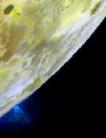 On
Io, the process is similar but instead of water the material
that comes in contact with the heat source is sulfur. These
geyser-like features on Io are called plume eruptions.
Compare this picture with the one above. The top picture is
of a geyser in Yellowstone National Park, Wyoming. The
second picture is of the Masubi plume eruption on
Io.
On
Io, the process is similar but instead of water the material
that comes in contact with the heat source is sulfur. These
geyser-like features on Io are called plume eruptions.
Compare this picture with the one above. The top picture is
of a geyser in Yellowstone National Park, Wyoming. The
second picture is of the Masubi plume eruption on
Io.
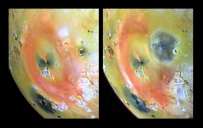 With
so much volcanic activity on Io, it is not surprising that
its features have been given the names of gods and goddesses
of fire and volcanoes from ancient mythologies of different
cultures. The large, orange, ring-shaped feature is
called Pele, named for the Hawaiian volcano goddess. Another
large feature on Io is a black horseshoe-shaped lava lake
called Loki, named for the Norse god of fire and magic. Due
to all the volcanic activity, Io's surface features change.
You can see some of the changes that occurred between April
1997 and July 1999 at the volcanic center, Pele in these
pictures. Notice in the second picture that a new, large,
dark spot can be seen within Pele's red ring which cannot be
seen in the first.
With
so much volcanic activity on Io, it is not surprising that
its features have been given the names of gods and goddesses
of fire and volcanoes from ancient mythologies of different
cultures. The large, orange, ring-shaped feature is
called Pele, named for the Hawaiian volcano goddess. Another
large feature on Io is a black horseshoe-shaped lava lake
called Loki, named for the Norse god of fire and magic. Due
to all the volcanic activity, Io's surface features change.
You can see some of the changes that occurred between April
1997 and July 1999 at the volcanic center, Pele in these
pictures. Notice in the second picture that a new, large,
dark spot can be seen within Pele's red ring which cannot be
seen in the first.
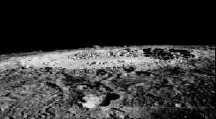 Many
of the moons and planets in the solar system show signs of
impact craters. These form when meteorites, chunks of
interplanetary material, strike the surface of a planet or
moon leaving behind a large hole in the ground. This picture
shows a large impact crater on our moon. Although meteorites
must also strike Io's surface, there are no signs of impact
craters. Because material is constantly erupting from its
interior onto the surface, impact craters are filled in soon
after they appear.
Many
of the moons and planets in the solar system show signs of
impact craters. These form when meteorites, chunks of
interplanetary material, strike the surface of a planet or
moon leaving behind a large hole in the ground. This picture
shows a large impact crater on our moon. Although meteorites
must also strike Io's surface, there are no signs of impact
craters. Because material is constantly erupting from its
interior onto the surface, impact craters are filled in soon
after they appear.
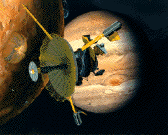 In
1989, NASA sent another spacecraft to study Jupiter and its
moons. This spacecraft was given the name Galileo in
honor of the man who discovered Io and its neighboring
moons. Since its arrival at Jupiter in 1995 Galileo has
given us a tremendous amount of new information about Io,
and still today is helping us to find answers to the many
questions we have about this fascinating world!
In
1989, NASA sent another spacecraft to study Jupiter and its
moons. This spacecraft was given the name Galileo in
honor of the man who discovered Io and its neighboring
moons. Since its arrival at Jupiter in 1995 Galileo has
given us a tremendous amount of new information about Io,
and still today is helping us to find answers to the many
questions we have about this fascinating world!
Photos and Illustration Credit: JPL/Nasa
Geyser Photo Credit: S.R. Brantley, USGS
Now that you have learned about Io, try these fun activities and puzzles!
- Kids Activities - Make your own volcano, geyser, and lava flow!
- Io for Kids Interactive Crossword Puzzle - Solve a puzzle on-line!
- Io for Kids Crossword Puzzle - Print out a puzzle to share with your friends!
